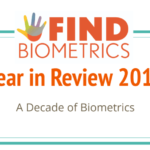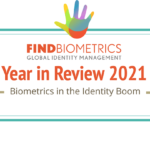The FindBiometrics Year in Review is a massive industry event, collecting the opinions of biometrics industry experts from a wide range of backgrounds. Each year our industry survey checks the industry pulse on the popularity of biometric modalities, the excitement around specific vertical markets, and attitudes toward critical industry issues like privacy, regulation and public perception.
Our 2019 survey collected responses from over 230 industry experts, and our analysis of the results thus far has been enlightening as we set the stage for a new decade of biometrics. To balance out the larger industry discussion, it’s time to take a look at how 2019 was for many of the companies and organizations that participated in the Year in Review.
FindBiometrics reached out to survey respondents, asking for a snapshot of their year, their opinions on industry opportunities, and what we can expect so see from them in 2020. In part three of our multi-part series, we are profiling answers from TypingDNA, Aratek, and LumenVox.

What was your company’s biggest accomplishment in 2019?
2019 was an excellent year for TypingDNA. After successfully raising $1.5M in a seed round funding, the company’s headcount tripled while adding experienced and valuable members centered around development, marketing, sales, and operational. We also created a sales hub in North America to be able to serve US clients faster while building strong partnerships in the region.
Apart from operational accomplishments, from a technology point of view, we managed the development and launch of breakthrough mobile technology. Our proprietary AI-based technology is now seamlessly working on mobile devices analyzing keystroke times and mobile sensory data and is available for Android, iOS, and ReactNative. TypingDNA captures typing patterns and matches them with previous samples to authenticate users.
Another success was the European Banking Authority’s approval of typing biometrics as compliant to be used in multi-factor authentication under the Payment Services Directive – PSD2, a section called SCA (Strong Customer Authentication). Keystroke dynamics were among the inherence elements listed by EBA.
This decision has brought typing biometrics in the attention of European banks and other financial institutions looking for compliant yet easy to use authentication.
What is the greatest opportunity facing the biometrics industry?
Today, online accounts are hacked more often than ever. A hacker attacks roughly every 39 seconds, and it’s estimated that 65 percent of companies have over 1,000 stale accounts. Even worse, online fraud is causing businesses across the world to lose $4.2 trillion each year.
Therefore, most companies recognize the advantages of biometrics and other authentication methods to help straighten user security. We consider that a multi-modal approach in which biometrics have a significant role is the main direction to follow.
Cybersecurity and online account protection aren’t the only opportunities facing the biometric industry. Consumer-centric products combined with biometrics are booming in banking and finance, and the main reason standing behind is the ease of use and high adoption rates.
What does your company have in store for 2020?
We strive to better our technology and bring innovative products to our customers and partners worldwide. The accuracy of our AI-based algorithms depends on the training and testing we perform, so we aim to invest even more resources in this fundamental phase.
Since we are a software platform and the core product is our API, we are looking forward to integrating our technology everywhere while making sure we become better and better at one core thing: typing biometrics.
In early 2020, TypingDNA raised a $7M Series A from Gradient Ventures, Google’s AI-focused venture fund and other participants such as EU-based fund GapMinder, Techstars Ventures, and other prior investors. We plan to use the round of investment to improve the typing biometrics adoption worldwide and creating TypingDNA’s developer support network and tools to integrate our API with popular web development platforms.
Another goal is to find suitable partners that can support us on the quest to innovate the biometrics field. We are currently in an exploratory phase where authentication seems the be one of the most suitable use cases for typing biometrics. Still, we believe typing biometrics can enhance human lives and better technology in various ways. Therefore, TypingDNA’s researchers focus on developing different tools based on typing biometrics for better-performing technology.
Last but not least, TypingDNA is on the mission to become THE typing biometrics technology everybody uses. Providing easy to use, non-intrusive biometrics, and enhanced security to people worldwide is a first step towards accomplishing this goal.

What was your company’s biggest accomplishment in 2019?
Aratek’s intensified focus on product development has yielded a number of breakthroughs in 2019, chief of which is the TruFace facial matching series.
The market has responded very favorably towards the TruFace line, which is positioned to fill the growing demand for facial recognition terminals that are reliable and cost-effective.
Our R&D listened closely to what the customers really need, allowing us to come up with a winning feature set for TruFace: (1) Built-in HDR dual-camera system that detects ambient lighting levels and then controls the near-infrared LED accordingly. It allows high quality captures in all lighting conditions, whether in a dark room or even in the bright outdoors, (2) Algorithm-based Live Face Detection, a feature made possible by Aratek’s patented TrustFace algorithm. Since it’s not dependent on hardware, TruFace is an inexpensive and reliable solution for many identification and authentication applications.
Another banner accomplishment in 2019 is the STQC certifications notched by the A400 and A600 fingerprint scanners, just a year after they captured FBI certification.
These new certifications squarely put Aratek in a position to help the Indian government enroll about 600 million citizens in the Aadhaar, and have opened up exciting opportunities where Aratek’s biometric technology may be applied to directly help the Indian people.
Ahead of the STCQ certification, the A400 and the A600 scanners have both also secured the FBI PIV / Mobile ID FAP 10 and FAP 20 certifications respectively, which guarantee superior image quality, usability of output, and inter-operability.
What is the greatest opportunity facing the biometrics industry?
As the world grows more complex, the biometrics industry will be front and center of bringing order to chaos. Facial matching, for instance, is jumping out of smartphones into wider usage everywhere. Already, the UIDAI of India is planning a full implementation of facial recognition for the country’s Aadhaar National ID cards. Moreover, governments around the globe are spending heavily on face-enforced surveillance and secure identification and authentication, driving the explosive growth of this market which is expected to reach a value of USD 9.06 billion by 2024.
Multimodal biometrics, or the combination of two biometric modalities in an identification and authentication system, is also predicted to gain significant ground as enterprise continues to seek better ways to secure systems. For example, fingerprint and facial matching are robust modalities in themselves. When combined, however, they bring a whole new level accuracy and reliability. Multimodal biometrics will experience rapid growth because they provide the supplemental, and often the crucial data from among different modalities to mitigate any possible shortcomings of a single biometric modality. Aside from physical biometrics (face recognition, iris recognition, and fingerprint recognition), behavior-based biometrics (signature, gait, voice and recognition) are also seen to gain wider and wider usage.
Aratek’s TruFace line includes the BA8200 and BD8500 multimodal biometric terminals which are both equipped with facial recognition and fingerprint matching capabilities, working in tandem to achieve peerless security and reliability in all identification and authentication applications.
The headlines aren’t lying. The never-ending war between security experts and cyber-criminals is real and will only escalate in the years to come with the emergence of more and more sophisticated methods of attack. We predict, therefore, a wider adoption of multi-factor authentication with biometrics, where two or more independent credentials are combined with biometrics. Thus, what the user knows (traditional password), what the user has (security token such as OTP), and what the user is (biometric verification) can all be used in combination to create a more impregnable wall to keep attackers at bay. This works because even if one factor is breached, the criminal would have to contend with two or more others before actually compromising the system.
With border security a hot issue these days, authorities are fast relying on the multifactor authentication offered by Aratek’s Marshall-M to keep their countries safe. The Marshall-M combines MRZ functionalities with a whole panoply of other factors such as fingerprint and NFC applications to give the utmost in security. Similarly, the Aratek BM5520 is helping prevent unauthorized entry with a combination of fingerprint scanning and matching, contact and contactless smart card reader, and 2D barcode scanner.
What does your company have in store for 2020?
Product development will continue to drive Aratek in 2020, where we expect to develop a full range of modules and scanners of all sizes and specifications. The aim is to smoothly integrate our superior biometric technology into the ever growing range of identity-based services and applications.
Aratek plans to keep partnering with governments and enterprise in the efforts for greater financial inclusion because we believe the unbanked deserve to be welcomed into the financial system and enjoy many benefits.
We are hatching a lot of exciting things in our labs at any given time, and we will soon see the deployment of facial recognition technology in our mobile terminals. This next-generation facial matching technology is envisioned to help authorities boost their counter-terrorism efforts and improve service delivery to their citizens.
We are also working on a cloud identity management rental service, aimed squarely at organizations which need identity management but do not have the capability to run it themselves. We realized that Aratek’s vast experience is a key factor that we can leverage into providing managed services that can provide real solutions to real needs.

What was your company’s biggest accomplishment in 2019?
It’s was an incredible year for LumenVox, especially in terms of product introduction. We not only hit over a million voiceprints from our global customers, we also released our most advanced and accurate voice biometrics engine to date. Our development team combined customer feedback with their biometric expertise and spent countless hours creating this engine, which allows for machine learning to enhance features and customer benefits. With the inclusion of deep neural network technology, Lumenvox has positioned itself to provide higher accuracy, greater flexibility, more fraud prevention tools and increased customer satisfaction/service. Furthermore, we have productized for quick startup, enabling swift implementation without long API development demands on the customer. We have also increased operability between our two flagship solution suites—speech (recognition) and authentication (voice biometrics). The sky is truly the limit when it comes to voice channels and the solutions we have created using this modality.
What is the greatest opportunity facing the biometrics industry?
Authentication in general gets us very excited because the need for it spans nearly all industries—financial, health, etc. Our goal with our solutions is to inherently reduce the risk of fraud while improving the customer journey. The use cases for voice biometrics as authentication are endless – we see it used in self-service transactions, or to maintain HIPAA and PCI compliance. It also addresses common headaches for both customers and agents by providing a multimodal/omnichannel experience in which the user can be anywhere (this only requires an access to a mic, commonly found on phones). Additionally, customers no longer need to deal with cumbersome authentication processes and are protected from weak security measures which leave them and their sensitive information vulnerable to fraud.
Basically, Voice Biometrics + Multi-factor Authentication = Less headaches, and way more trust and confidence – for customer, agent and the company itself.
What does your company have in store for 2020?
We’re taking our authentication and fraud prevention to another level. We see with our clients that brand trust is tenuous as fraudsters get more and more sophisticated with time and technology. One fraudster can completely tear down decades of carefully-built brand recognition and trust. We’re excited to introduce multiple fraud prevention tools that will prevent our partners from being vulnerable to these attacks. These tools now accompany our authentication suite, creating a more comprehensive response to our customers’ common fraud issues.
We’ve seen time and time again that these solutions…
- Increase customer satisfaction with a seamless authentication method
- Enhance security
- Reduce fraud risk
- Result in greater operational efficiency
- Reduce labor and cost
And we know the applications for this new engine and accompanying tools will only continue to grow. For us, the future is bright. And we’re ready to get down to business to make it even brighter.
*
Stay tuned to FindBiometrics as we continue to highlight the participants of our 17th Annual Year in Review.
—
February 13, 2020 – The FindBiometrics Editorial Team






Follow Us